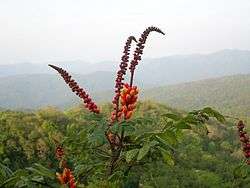Moullava spicata
Moullava spicata is an endemic species of creeper found in the Western Ghats of India.
| Moullava spicata | |
|---|---|
 | |
| Scientific classification | |
| Kingdom: | |
| (unranked): | |
| (unranked): | |
| (unranked): | |
| Order: | |
| Family: | |
| Subfamily: | |
| Tribe: | |
| Genus: | |
| Species: | M. spicata |
| Binomial name | |
| Moullava spicata | |
| Synonyms | |
|
Wagatea spicata Dalzell 1851 | |
Description
- It is a robust woody climber, having recurved prickles on its branches.
- Leaves - compound, bipinnate, 23–30 cm long with 4 to 6 pairs of pinnae, each 7.5 to 12 cm long, and having 5 to 7 pairs of oblong, coriaceous and dark-green leaflets on each pinna. The main rachis is armed with prickles.
- Flowers - sessile in dense spicate racemes reaching 60 cm long; the rachis is grooved with soft hairs, armed with prickles.
- Corolla - has 5 petals, inserted on top of the calyx-tube, obovate-spathulate, dark orange. 1 cm long, doesn't open fully.
- Calyx : scarlet,
- Androecium : has 10 stamens.
- Fruit - a linear oblong pod, swollen above the seeds and constricted between them.
- Seeds - 3 to 4, oblong, hard, bony.
.jpg) Bipinnate leaves
Bipinnate leaves.jpg) Inflorescence
Inflorescence_(5505608017).jpg) Fruit
Fruit Seeds
Seeds
Natural history
M. spicata is a creeper endemic to the moist deciduous and semievergreen forests of the Western Ghats.[3][5] The creeper flowers and fruits from October to May.[5] The flowers are frequented by birds and insects.
Uses
The seed of M. spicata yields an oil used for burning in lamps.[3]
Local names
Local names in the different ranges of the Western Ghats are:[2][2]
- English: Candy Corn plant
- Marathi: Wagati वागाटी, Wakeri वाकेरी
- Tamil: Okkadikkodi, Pulinakkagondai
- Kannada: ಗಜ್ಜಿಗಾಬಲ್ಲೀ Gajjigaballi
References
- "Moullava spicata". International Legume Database & Information Service (ILDIS) – via The Plant List.
- "CandyCorn Plant". Flowers of India. Retrieved 11 March 2018.
- P. Setu Madhava Rao, ed. (January 1961). Maharashtra State Gazetteer, Botany, Part III - Miscellaneous Plants. General Series Volume A (2 ed.). Mumbai: Maharastra State. p. 168.
- Shrikant Ingalhallikar (November 2001). Flowers of Sahyadri. Pune: S. Ingalhallikar. p. 79.
- Sardesai, Milind; Govekar, Ravikiran; Yadav, SR (2013). Field Guide to the Plants of Sahyadri and Konkan. Pune: Forest Department, Government of Maharashtra. p. 153.
External links
| Wikispecies has information related to Moullava spicata |
This article is issued from Wikipedia. The text is licensed under Creative Commons - Attribution - Sharealike. Additional terms may apply for the media files.